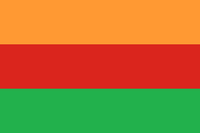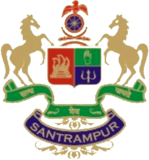Santrampur
| Santrampur Brahampuri,Sunth સંતરામપુર, संतरामपुर | |
|---|---|
| Santrampur | |
 Santrampur  Santrampur | |
| Coordinates: 23°11′22″N 73°53′34″E / 23.1895°N 73.8928°ECoordinates: 23°11′22″N 73°53′34″E / 23.1895°N 73.8928°E | |
| Country |
|
| State | Gujarat |
| District | Mahisagar |
| Ward | 6 |
| Santrampur Nagarpalika | Established 15 April 1994 |
| Government | |
| • Body | Nagarpalika |
| • President | Shivabahi Vankar |
| • Chief Officer | H. J. Agrawal |
| Area | |
| • Total | 16.00 km2 (6.18 sq mi) |
| Elevation | 140 m (460 ft) |
| Population (2011) | |
| • Total | 19,465 |
| • Density | 1,200/km2 (3,200/sq mi) |
| Languages | |
| • Official | Gujarati, Hindi, |
| Time zone | UTC+5:30 (IST) |
| PIN | 389 260 |
| Telephone code | (91) 2675 |
| Vehicle registration | GJ-17/GJ-35 |
| Literacy Rate | 84.99% |
| Legislature type | Nagar Palika (Municipality) |
| Legislature Strength | 24 |
| Lok Sabha Constituency | Dahod |
| Vidhan Sabha Constituency | Santrampur |
| Climate | Tropical savanna (Köppen: Aw) |
Santrampur, which used to be known as Brahampuri, is a historical town of Mahisagar District in Gujarat State of India. It serves as administrative headquarter of santrampur tehsil and is located in the banks of suki river. The town surrounded by verdurous greenery, is situated in the lap of aravalli hill ranges. It is 155 Km away from the state capital Gandhinagar.
As of 2011, Santrampur had a population of almost 19,000+ people. The town is known for its historical tower built in the western part of the city. An open air market, called Haat bazaar take place on every Tuesday in the town. The town houses various heritage buildings, administrator offices and renowned educational institutions.
History
King Zalam Sinh of Malwa dynasty established his kingdom in Jhalod in the 11th century.They came here from Chandravati town in Mount Abu. Another folkwell is that they have came from Dhar State of Madhya Pradesh. Against the attacks of Muslims, It becomes difficult to survive for King Zalam Sinh and he became martyrs in the war. Kunwars of Zalam Sinh, Sant and Limdev left Jhalod with handful of warriors and came towards left in the hilly areas. Bhil people were living in these areas and it was their dominance. Sant and Limdev lived in these forests for so many years. After that, they have established their dominance here and developed their kingdom by making Sunth or Sant as a capital of their state in 1255 AD.[1] It becomes Sant State of princely states in western India during the colonial British Raj.[2]
 Flag of Sant State
Flag of Sant State Symbol of Sant State
Symbol of Sant State
Geography
Santrampur is located at 23°11′22″N 73°53′34″E / 23.1895°N 73.8928°E in western India at an elevation of 140 metres. It is the town with an area of 16 square kilometers and a population of 19,445, according to the 2010–11 census. The town sits on the banks of the Suki River, in central Gujarat. The Suki river frequently dries up in the summer, leaving only a small stream of water.
1857 Revolt In Santrampur
Rebellion in soonth state by a jamadar named Mustufa khan son of sitar khan is one of the instances of the fact that were no longer in the control of the darbar who employed them Under Mustufa khan leadership bhil,koli and muslim fought against British rule in soonth state(now santrampur). Maharaja bhuwansinhji Raja of soonth state wrote letter dated 6th august 1857 to captain buckle pleading for the immediate dispatch of the british troops Wrote: "I am as anxiously expecting your support as one expects rain in session.although the payment to jamadar mustufakhan of the arrears of salary due to him,is withheld on order from sirkar he disregarded that order" Seriously Wounded in the battle against the British Force under Lieutenants alban Tomb of Saheed(Martyr) Mustufa Khan Situated In Santrampur Muslim Kabrastan,Every Year his urs(Death Anniversary) is celebrated by people of santrampur [3] [4] Book Name : Who's Who of Indian Martyr vol 3
Civic Administration
Santrampur is administered by the Nagarpalika. The Nagarpalika was established in April 1994 under the Gujarat Municipalities Act - 1963.[5] For administrative purposes, the city is divided into six wards. The principal responsibility of Nagarpalika to ensure an overall development of the Santrampur agglomeration covering an area of 16 km2. Four corporators are elected from each ward, who in turn elect a president. Executive powers are vested in the chief officer, who is an officer appointed by the Gujarat state government. Nagarpalika is responsible for Water supply, Hospitals, Roads, Street lighting, Drainage,Fire brigade, Market places, Records of births and deaths, Solid waste management, Maintaining gardens, parks and playgrounds, Providing education to unprivileged children etc.[5] The Santrampur Police Station is headed by a Police Inspector (PI), appointed by Government of Gujarat.
The City elects One member to the Lok Sabha (parliament), which comes under Dahod (Lok Sabha constituency) and One to the Gujarat Vidhan Sabha(Assembly), which comes under Santrampur (Vidhan Sabha constituency). One assembly seat of Santrampur was won by the BJP during the legislative elections in 2017. In the 2018 Nagarpalika elections, the BJP won 14 seats, 5 seats went to the Congress and 5 to others.
Demographics
As of 2011 India census,[6] Santrampur had a population of 19,465. Population of Children with age of 0-6 is 2511 which is 12.90% of total population of Santrampur. In Santrampur , Female Sex Ratio is of 934 against state average of 919. Literacy rate of Santrampur city is 84.99% higher than state average of 78.03%. In Santrampur, Male literacy is around 91.58% while female literacy rate is 78.03%.
Visitor attractions
- Hava Mahel
- Mangadh Hill
- Kadana Dam
- Maa Bhuvneswari Temple
- Maa Harsiddhi Temple
- Fair Of Ravadi
- Sagdapada Village
- fair of aamli (batakvada)
References
- ↑ Chakrabarti, Jadab Chandra (1895). The Native States of India. Calcutta: S.K. Shaw. p. 239.
- ↑ Parmar, Ladhabhai Harji (1922). The Rewakantha Directory. Rajkot: Parmar Press. p. 53.
- ↑ https://www.google.co.in/search?tbo=p&tbm=bks&q=inauthor:%22Bombay+(India+:+State).+Committee+for+a+History+of+the+Freedom+Movement+in+India%22
- ↑ https://www.google.co.in/search?tbo=p&tbm=bks&q=inauthor:%22Publications+Division%22
- 1 2 "Gujarat Municipalities Act-1963" (PDF).
- ↑ "Census of India 2011: Data from the 2011 Census, including cities, villages and towns (Provisional)".